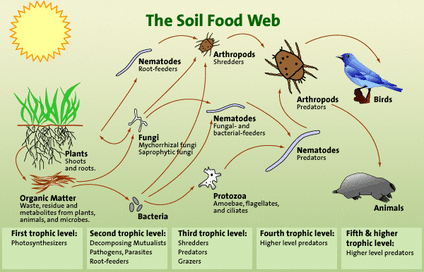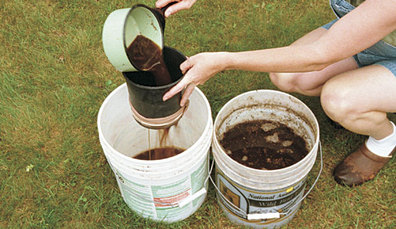
Cheffing a good compost and compost tea is the ONLY way to keep a soil's biology in balance. I was enlightened to this trade fact during the soil class that I recently took at the Rodale Institute (see October 10th). Anything else, and either the soil is not as healthy as it could be or is being managed with inorganic treatments. Compost tea is applied in the spring and summer unlike compost which is applied in the fall. Compost tea is also an efficient way (yes, organic has lots of efficiencies) of applying organic matter if there is not enough compost to spread around. It helps compost go further. Compost tea, however, is only as good as its compost and knowing first how to make compost will provide the theory behind this little known energy drink.
COMPOST BASICS
Once we understand how soil works (see October 10th post), it becomes obvious that good soil biology leads to good soil structure. And it starts with compost! Compost provides the scheduled dose of biology that soil needs to grow healthy plants. It carries all the organic matter and living organisms to the soil. When you think of it, compost is just mimicking nature's biology. Old growth meadows and forests decompose plants and leaves cyclically. Applying compost brings that same type of biology to the crop's soil.
While things like pH tests provide important information about nutrient deficiencies, it is more important to know that the fungal biomass to bacteria ratios are strong and that there is a diverse mix of insects (arthropods), nematodes, earthworms and protozoa thriving in the soil. If those things are present, the soil's foodweb will be strong and the nutrient cycling in the soil will be strong. Together, it keeps the soil aerobic and the biology in balance. Does this mean that fertilizers, herbicides and pesticides are unnecessary? Yes! In conjunction with other good organic, farming practices like cover crops, crop rotation and inter-cropping, compost and compost tea gives the soil all the nutrients it needs. Under these healthy conditions with lots of fungal biomass, weeds don't have the bacteria ratio to proliferate and the plant's immune system is strong and can ward off pests. If a garden or farm has sickly plants, lots of weeds or an outbreak of pests, the first thing to ask is, "what's wrong with the soil?" it should not be, "grab the spray!" Good compost will help fix the problem and correct the imbalance.
As the compost revs up the nutrient cycling, the root structure develops decreasing soil erosion and increasing the soil's water retention thus making it more drought tolerant. Root structure doesn't just mean more roots but longer roots that can access water deeper in soil horizons. For instance, regular grass may only have roots that are 4-6 inches but with the right compost, roots can grow as deep as 4-5 feet. Feet I say! With that kind of network, soil can hold more water and roots can go deeper for more water. Win-win! Then there is all the carbon which can be sequestered but we'll devote a whole separate discussion to that.
All of this new found knowledge would not have been made possible if it weren't for Dr. Elaine Ingham, PhD. I had several light bulb moments during the class but the one which flipped the really big switch was when she said, "if you have the right compost, you can fake a crop rotation." Whoa! That proved not only the power of compost but provided another trump card for my back pocket when talking it up with those who rebut the credibility of biological organics.

When it comes to making compost, there are a few different roads to take. There is the choice between thermal (hot) or vermiculture (worm) compost. Within thermal composting you have the 21-day, slow and kitchen compost recipes. The super cool part...compost doesn't rely on sun or outside temperature. If done properly, the microbes will generate the heat needed indiscriminate of the weather. Dr. Elaine has made compost in sub-zero temperatures. I love biology!
Dr. Elaine and her squad at the Soil Foodweb have several resources on making compost and compost tea. Here is a great article by Elaine featured on www.finegardening.com which takes you all the way through the process. For this exercise, I will share the basic concepts for thermal composting. Composting can sound complicated, smelly, time consuming and costly. Taking the right steps will keep the hassle, time, cost and smell down. Keeping the smell down, keeps the critters away and the method Dr. Elaine uses eliminates the need for expensive compost contraptions like tumblers. All thermal recipes have varying proportions of three ingredients: green waste (including food waste and coffee grounds), woody stuff (leaves, paper, sawdust, wood chips) and nitrogen (manure, legumes). The addition of nitrogen begins the composting process. And the amount determines how fast the compost cooks. In other words, hold onto your greens and woody stuff and add the nitrogen component when your ready to activate the process. At which time, it becomes a schedule of turning the compost when the core temperature reaches certain degree points. Closing tid bit...compost should have 50% moisture content. huh? it's easy...just take a fist-full of compost from the middle of the pile and squeeze it. If one to two drops of water seep out, you're golden! If not, spray some water on the pile. Okay, one more fun fact from Dr. Elaine..."You can't ever apply too much compost, just compost that wasn't made properly." She's one wise grasshopper.

 RSS Feed
RSS Feed
